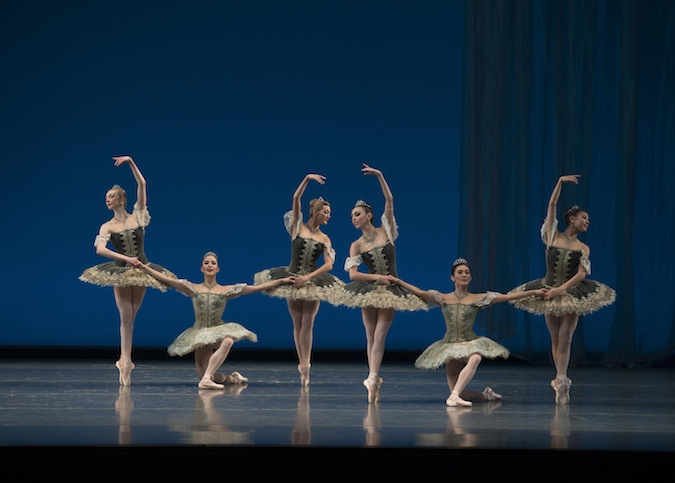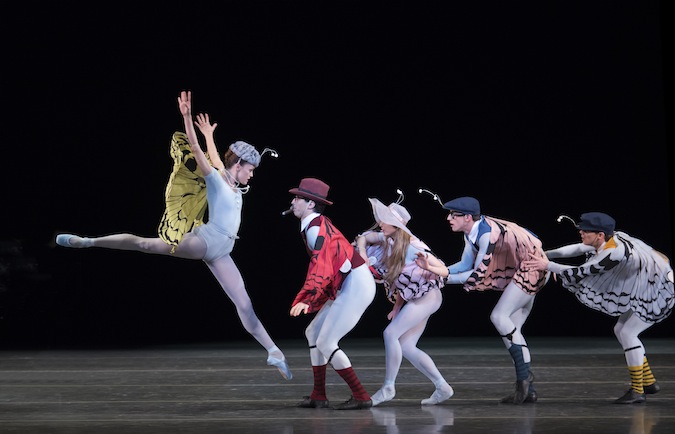Dance Review: Boston Ballet — Play With Music
Two 20th century gems bracketed the evening, and all four works showed how the ballet idiom can serve and be served by classical music.
Thrill of Contact, staged by the Boston Ballet at the Opera House, Boston, MA through May 24.

Emily Mistretta and Bradley Schlagheck performing in the Boston Ballet’s production of Jeffrey Curio’s “fremd.” Photo: Gene Schiavone.
By Marcia B. Siegel
Boston Ballet’s final program for the 2014-15 season had a musical center. Two 20th century gems bracketed the evening, and all four works showed how the ballet idiom can serve and be served by classical music. The new work, fremd, by principal dancer Jeffrey Cirio, delivered the electronic thumps and whines that prop up much of the company’s recent repertory, but that piece also inserted atmospheric nocturnes by the Romantic composers Frederic Chopin and John Field.
Not that Cirio’s ballet has much real romance in it. He uses an anti-balletic vocabulary, twisting and splaying the body millions of ways. A barechested muscle man (Altan Dugaraa) begins the piece with pumped-up strivings in one half of a stage split into two separate chambers by lighting. (Designer was John Cuff.) In the darker half, four figures in long-sleeved tops and shorts stand facing away from the hero. In some informal remarks, Cirio has said he sees the ballet as a man’s encounters with his past life.
This explains the four figures and another couple who emerge later from the darkness. These ghosts or memories work mainly in pairs (Lia Cirio and Paulo Arrais, Whitney Jensen and Paul Craig, Emily Mistretta and Bradley Schlagheck). They confront each other and clamp together for duets with body-centered flexions and stretched limbs. They seem to pay as little attention to the sounds around them as they do to their companions. In addition to the piano pieces (played by Alex Fooksman), there’s muffled drumming like an amplified heartbeat, and a man speaking in German on the radio. After several minutes of introspective exertions and reconnoitering, Dugaraa steps warily over the boundary and joins the memories.
William Forsythe’s 1996 The Vertiginous Thrill of Exactitude, new to Boston Ballet, was staged by Jill Johnson, a former Forsythe dancer who’s now the head of the dance program at Harvard University. Forsythe used the Allegro Vivace fourth movement from Schubert’s Great C Major symphony to compress a lot of classical ballet material into eleven minutes. The chamber-size ensemble (Schlagheck and Kathleen Breen Combes, Erica Cornejo, Misa Kuranaga and John Lam) wore purple shorts for the men and stiff lime green tutus for the women. They rushed through so many steps I couldn’t really track what they were building or how it related to Schubert.

A scene from the Boston Ballet production of “Theme and Variations.” Photo: Gene Schiavone
The two vintage works on the program, George Balanchine’s 1947 Theme and Variations (from Tchaikovsky’s Third Orchestral Suite) and Jerome Robbins’s 1956 The Concert (Chopin piano pieces), celebrated classical ballet by invoking the range of talents that the discipline demands of dancers and audience. I’ve seen both of them many times before; great bygone performances are imprinted on my mind, but these presentations held up beautifully. Theme is a terrific exposition of how choreography can be a visual echo and a compliment to a musical structure. The Concert is a sophisticated comment on musical and balletic conventions and one of the funniest ballets ever made. Boston Ballet’s Russell Kaiser and Margaret Tracey, both former New York City Ballet dancers, staged the works.
Misa Kuranaga and Jeffrey Cirio led the large cast of Theme and Variations: four secondary couples and a corps of eight women who acquire their own partners at the very end. Santo Loquasto designed the handsome tutus and tunics in subtle shades of moss green that defined the different cadres. Balanchine started, as did Tchaikovsky, with an elementary phrase. Lifting the arms and extending a leg, (port de bras, tendu) the ballerina and danseur demonstrate these ABCs in alternating, elaborating four-bar statements. The phrase expands to the corps de ballet, and the whole thing grows and mutates until a final polonaise where all thirteen couples promenade in intricate precision patterns.
The variations in between allow the two principals, the demi-couples, and the corps their own embellishments. In the space of half an hour, we see each of the principals in virtuosic solos. She has very fast, picky step-work. He gets jumps and turns with detailed legwork. She’s supported on pointe by the female corps, all of them hovering on their toes and grapevining in and out while holding hands. The corps dance their own fugue. And the principals have a majestic pas de deux.
The ballet takes intense concentration as well as technique. I was impressed with Kuranaga’s ability not only to do the steps but to use the music in her own way. She sped up on a series of fast traveling turns. She was able to impose tiny alterations in midstream so that a sequence of repeated steps didn’t look all the same, and made a partnered maneuver look lively instead of awkward. Cirio excelled as the elegant male lead, though he wasn’t as expansive in space as his Boston predecessor James Whiteside, who’s now a principal at American Ballet Theater.

A scene from the Boston Ballet’s production of “The Concert.” Photo: Gene Schiavone
When the house curtain went up on Saul Steinberg’s witty front drop for The Concert, a stage-eye view of the audience, the person behind me exclaimed, “Yay! A real ballet!” Then she asked, as pianist Freda Locker sat down and daintily tweaked a cloud of dust off the keys, “Is this a comedy?” The Concert is both of those things. Made in 1956 for the legendary Tanaquil LeClerq and the New York City Ballet, the work was revised by Jerome Robbins a few times, and as a loving burlesque it’s been personalized by succeeding casts of dancers. The idea is a Chopin piano recital where the audience of eight characters, dressed in accessorized powder blue leotards, act out their fantasies as the music transports them.
In addition to the snooty accompanist, there’s the ingenue in the floppy hat and pink scarf (Ashley Ellis), who drapes herself over the piano to listen; the cigar-chomping henpecked husband (Lasha Kozashvili) who plots the demise of his battleaxe wife (Dusty Button); the cowardly young man (Isaac Akiba) who’s overpowered by the ingenue in a passionate pas de deux.
The whole thing culminates in a grand finale of butterflies and Cossacks, to the Ballade in A flat, where Kozashvili captures Ellis, and the jealous wife gets flattened by a leaping insect chorus. Chopin triumphs at the end, when Locker goes after them with a huge butterfly net.
Internationally known writer, lecturer, and teacher Marcia B. Siegel covered dance for 16 years at the Boston Phoenix. She is a Contributing Editor for the Hudson Review. The fourth collection of Siegel’s reviews and essays, Mirrors and Scrims–The Life and Afterlife of Ballet, won the 2010 Selma Jeanne Cohen prize from the American Society for Aesthetics. Her other books include studies of Twyla Tharp, Doris Humphrey, and American choreography. From 1983-1996 Siegel was a member of the resident faculty of the Department of Performance Studies, Tisch School of the Arts, New York University
Tagged: Boston-Ballet, fremd, Jeffrey Cirio, Marcia B. Siegel, The Concert, The Vertiginous Thrill of Exactitude

[…] It’s hard to go wrong with works by Balanchine, Robbins, and Forsythe. Add in choreography by Boston Ballet’s own principal dancer Jeffrey Cirio, and you have Thrill of Contact — a powerful combination of athleticism and artistic intention. Arts Fuse review. […]